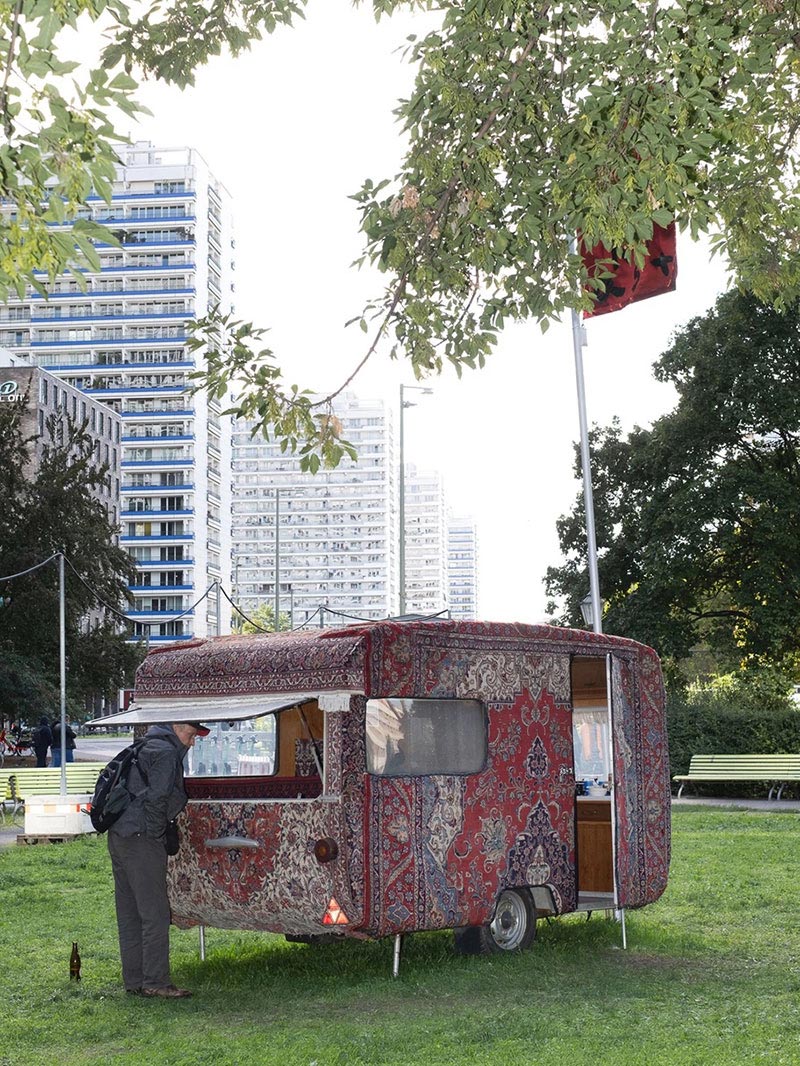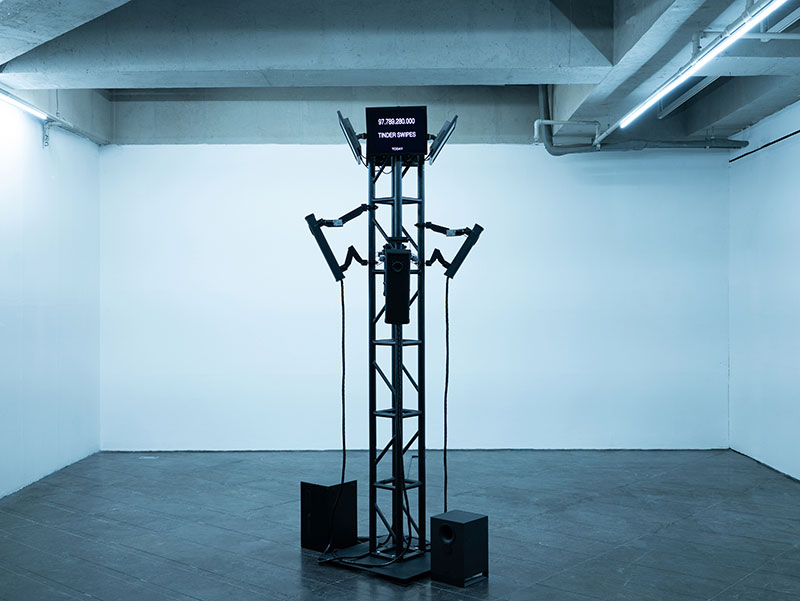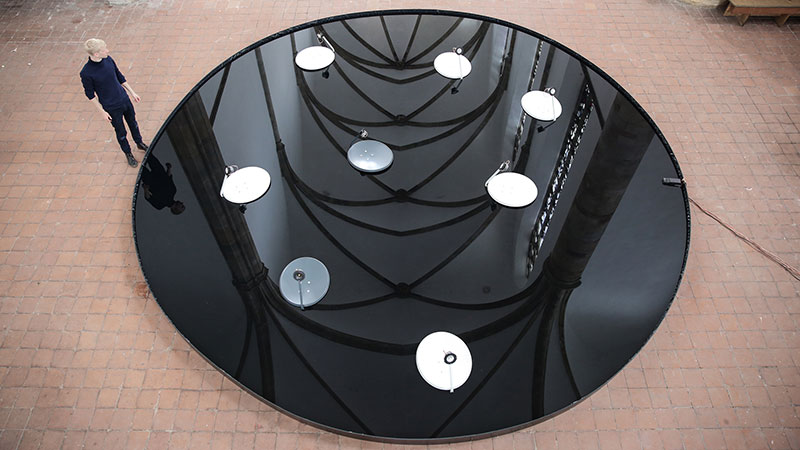Jan. 4, 2023
While two long years of pandemic had us feel disconnected and isolated, muffling all our interactions with masks, screens and an obligatory two-metre long distance, curators Keumhwa Kim and Pauline Doutreluingne yearned, as everybody else, for human contact and emotional affection. ‘Speaking to Ancestors’ is the way in which they tackled this essential need: a project aimed at re-establishing a connection with roots, family members, cultural rituals and traditions, at bridging distance with personal stories of migration and displacement. The series consists of seven exhibitions by seven artists who deal with this theme in seven different history-laden locations in Berlin. The first event comprised a performance and installation by Iranian artist Farkondeh Shahroudi at the historical crossroads that, today, is Spittelmarkt. The next iteration, ‘Rituals of Wasted Technology’ by Marco Barotti, opens on January 11 in the Kuppelhalle at Silent Green. We sat down with the two curators to learn more about the programme and their motivations behind the project.

Fahrkondeh Shahroudi: Suppenküche visitor with ‘Gülüzar’ (2022) and ‘Anti-Flag’ (2022), September 17, 2022 // Photo by Piotr Pietrus
Berlin Art Link: What inspired the concept behind this series and why did you feel the need to return to origins and look at genealogies now?
Keumhwa Kim: What prompted our research into origin stories and genealogies were the many discourses around human fragility in isolation that the pandemic brought about, as well as an increasing artistic interest in religion, the relationship between human beings and nature, and spirituality in the technoage. That and my own interest in Joseph Beuys and his approach to art. This was the lineage informing my desire to explore shamanism and animism today.
Pauline Doutreluingne: We also asked ourselves what collective rituals look like post-pandemic and whether an exhibition can have that function in contemporary society. We invited artists whose work is concerned with modern rituals, genealogy, the differences among cultures as well as the merging of them in a city like Berlin. Indeed, all the artists we selected share an experience of migration and work within the realm of identity and difference.
BAL: Could you talk a little bit more about the “memory spaces” you have chosen for your program? Are they chosen in consultation with the commissioned artists or is an artist assigned to a space?
PD: The locations chosen are meaningful as they connect to the content of the artists’ work. The concept of “memory space” is vital in Berlin, which is a city of memory itself. For example, the first exhibition by Farkhondeh Shahroudi was at Spittelmarkt, once the economical centre of East Berlin and now a forgotten social space that has become a heterotopic one. All the spaces chosen evoke painful memories, mystery and a unique story that every artist has been invited to entertain a dialogue with. It’s also very important to encourage a conversation with the communities that use these places and to allow this to have an impact on the artists’ work. The crematorium, which was chosen for Barotti’s exhibition, is a sacral environment and it obviously cannot be rented for a long period of time, which is often the case with Berlin and all cultural activities.

Marco Barotti: ‘APES,’ 2022, Loop Space Seoul // Courtesy of the Artist
BAL: What happens if the artist cannot work in the chosen space?
KK: Of course if the artist doesn’t like the place, we choose something else. It’s not always a smooth process as there are always a set of restrictions and conditions to take into account, especially because since after the pandemic the rents have risen so much. This is why many of the shows are so short. Nevertheless, it is still interesting to see how an exhibition can create a moment of community that is even more powerful because condensed into a short period of time.
BAL: Let’s talk about the sculptures that Barotti will be presenting at the Kuppenhalle. I was quite interested in the behavioural patterns mentioned in the press release, especially that will be generated through algorithms for his ‘APES.’ What sort of behaviour can the audience expect and will it be something we associate with the actual animal?
KK: The ‘APES’ will be enacting a kind of recursive motion that consists mainly of tree climbing and shouting. These movements and specific behavioural patterns are generated by data collected from statistics of online activity and consumption, in particular Facebook likes, Google searches, Tinder swipes, sent emails as well as cyber attacks.
PD: It’s the same impulses that social media triggers in us, so in this way Barotti’s work mimics human behaviour whilst placing it in a post-apocalyptic landscape. What happens if we take our repetitive behaviours and mix them with technology?

Marco Barotti: ‘SWANS,’ 2016, Kunsthalle Osnabrück // Courtesy of the Artist
KK: The ‘SWANS’’ sound on the other hand is a composition made by a group of musicians that were asked to improvise around the emotions of mourning, which suits the space the project is set in very well.
BAL: Where do these statistics come from? Are things like Tinder swipes so readily accessible to anyone with the prerequisite know-how?
KK: Barotti has cooperated with scientists from the CASA Institute for IT Security at Ruhr University Bochum. Moreover, the counters of cyber attacks he uses is made accessible by “Sicherheitstacho”, a platform initiated by Deutsche Telekom. All the information is available and privacy remains protected. Generally the behaviour patterns are more affected by the quantity of data collected rather than the quality of it.
BAL: The project comprises seven exhibitions by seven artists: was this number a fortuitous choice or is it somewhat meaningful?
KK: We actually had a longer list in mind but we had to narrow down our options for financial reasons. Eight exhibitions would have been more special because the number eight is meaningful in Chinese culture, but seven shows is already a quite ambitious project and we’re pleased with it.
BAL: When thinking about rituals and places of coming together there is also a tradition, a conformity to consider that a lot of people have tried to escape. Is there a critique of rituals that also occurs in the program?
PD: Not so much a critique but more of a research. We are rather looking at how to change the connotation of rituals since it is often associated with conservatism. Writer Sylvia Winter describes ceremonies as “means to emancipate humanity from global problems” and it’s this gathering potential that we want to emphasise. Although maybe at some point a critique will ensue throughout the seven exhibitions.
KK: Overall, all artists aim at expanding the traditional understanding of rituals turning them into fertile third spaces where hybrid, diasporic, transitional and transnational identities can thrive.
Exhibition Info
Speaking to Ancestors
Marco Barotti: ‘Rituals of Wasted Technology’
Exhibition: Jan. 12–15, 2023
Opening Reception: Wednesday, Jan. 11; 6pm
speakingtoancestors.de
Gerichtstraße 35, 13347 Berlin, click here for map




















